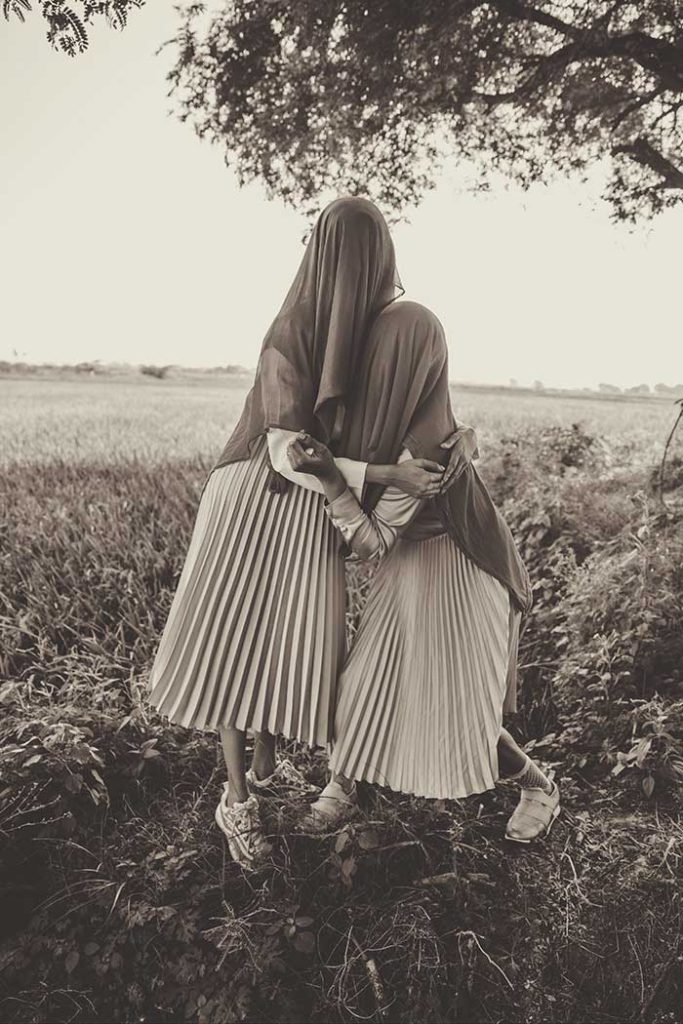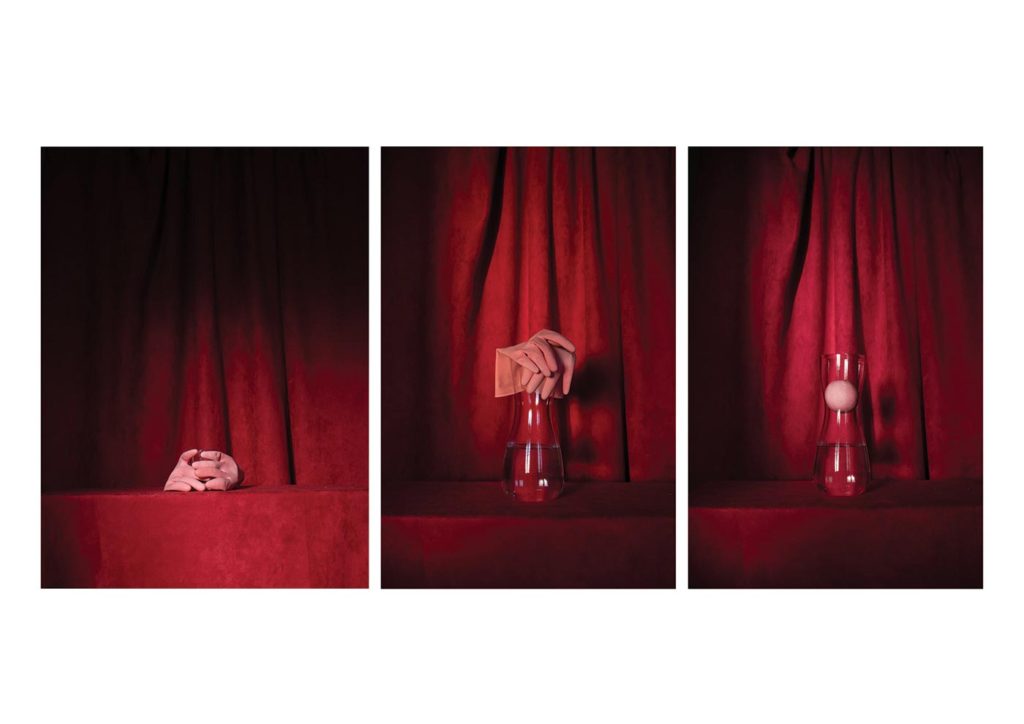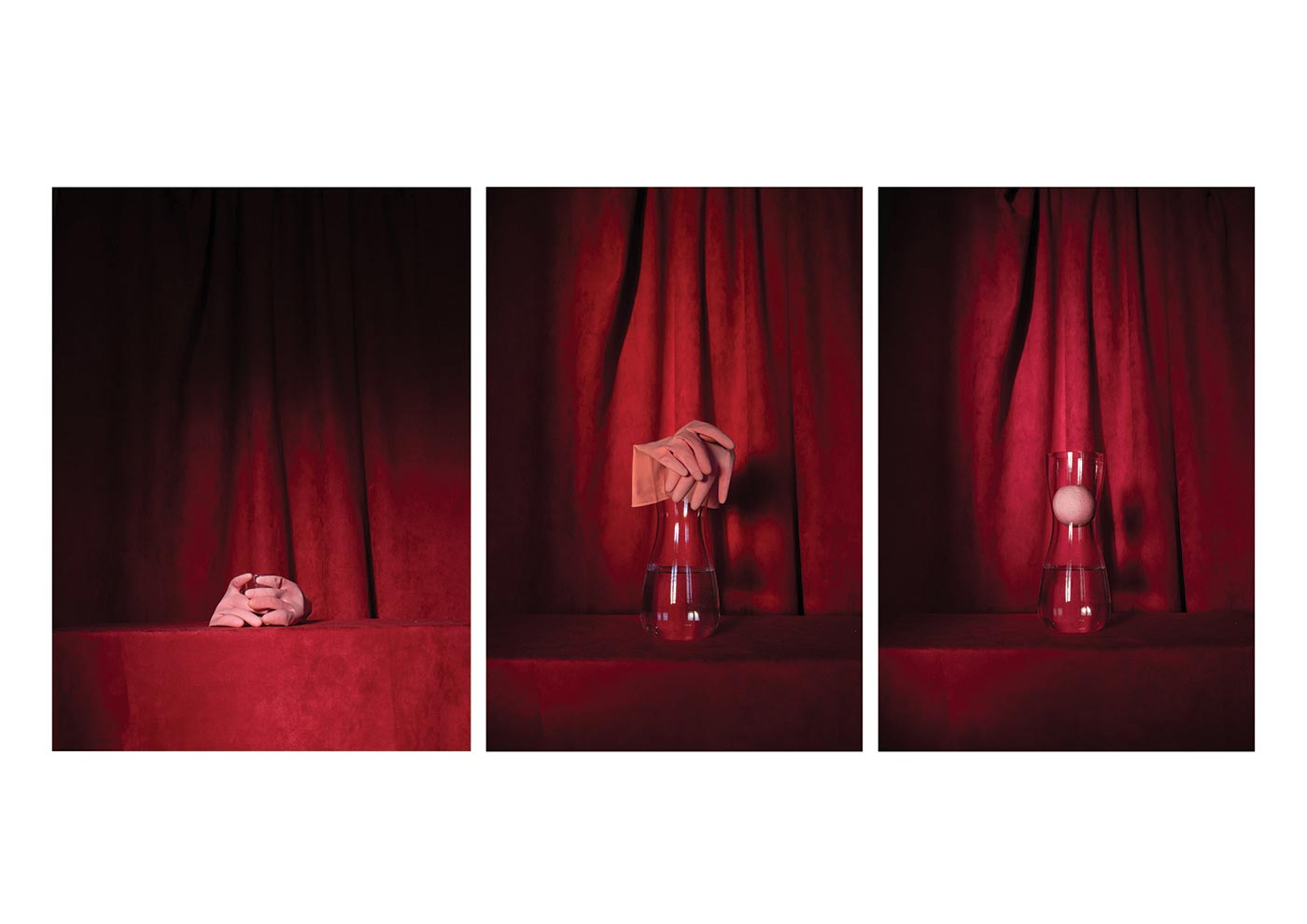Through her work, Neeraja Janardhanan tries to find a middle ground on convoluted and sensitive topics around beauty and societal norms.
Art is an emotion, and when art is synchronised with fashion, there is a meaningful and tangible perspective.
Featured image: Birth. Styled, Directed and Photographed by Neeraja Janardhanan.

Self portrait.
How did your tryst with art begin?
Art always existed in my life right from the start, and I loved it. However, the need to understand and experience art in its totality, came to me during my late teens. And it is still evolving.
I studied Fashion Design (Bachelors) and was completely intrigued by the process that went into creating a collection. While studying, I was drawn to the idea of conceptualising a story through visual aesthetic narrative. I decided to try my hand at art direction, fine art photography and editorial styling. Fashion to me, is my preferred form of art expression. I have a very intimate relationship with fashion and have contemplated fusing art with fashion. Art is an emotion. There is a meaningful and tangible perspective, when art is synchronised with fashion.

Self portrait.
How do you describe yourself in the context of challenging people’s perspectives via your work and art?
For my creative practice, an essential element is to understand the difference between inspiration and imitation. My work and my art are an expression of my personality – intimate and individualistic. Every time I create something, I do it for myself and I find it extremely meditative. The intent has never been about challenging people’s perspective. I believe we all have our own creative interpretation of the world around us and we are all creators in our own way. I acknowledge that the audience can interpret what they feel and understand from my work. It could be difficult to separate the art from the artist. Art comes from the artist while the latter is sustained because of the former.
I look at my city as a platform to introduce something fresh and new. Chennai is a city with many cultural differences. I believe introducing content that constitutes high fashion and an artistic spread will widen the mindset of the audience and add more flavour to the cultural differences. I often spend time creating a visual image of the outcome in my mind, make a sketch of my concepts on a plain white paper and brainstorm colours along with the mood.

Metamorphosis. Styled, directed and photographed by Neeraja Janardhanan.
How do you deal with the conceptual difficulty and uncertainty of creating new work?
I have to admit that my creative journey while working on anything new is always a bit skeptical. If I were to analyse this, I would say it comes from a fear of failure or disappointment, due to the mildly unrealistic expectations one sets for themselves. I believe many creatives relate to this. There’s always some sort of anxiety before you ideate and attempt to create something new, followed by the uncertainty of quality in the eventual achieved outcome. The insecurity and difficulty to predict the nature of creative execution becomes the adrenaline to my work.
I feel elated when people sometimes find a bit of themselves or seek refuge in my work. I work with a narrative on how my projects can be emotional and challenging. When I work on personal projects, I don’t draw barriers, I develop as I go. Mistakes add to the learning curve. I am almost never satisfied with my work, which I assume is an artist’s curse.

Alter-ego. Creative directed and styled by Neeraja Janardhanan. Photographed by Santosh Gunasekhar. Make up by Niruthya Murugesan. Model – Sahithya Jagannathan and Thiyagu.
What inspires you?
Fashion is a form of expression; it is visually phonetic. There is a language to fashion which works as a universal conversation of expression. I work on sensitive topics around beauty and societal norms. These might be very convoluted to some people, but I try to find a middle ground. Though it seems to stand against societal norms, I don’t want my work to come off as provocative. I want to normalise beauty and gender fluidity; want my work to be an emotional way of changing conditioned conformity. It is imperative that as an artist, I work to present my creative production in a manner that does not get lost in translation; I want to ensure that my art’s interpretive quality is retained as it changes form, function or medium.
I am aware though, that art is always going to be subjective and the viewer will bring in their own opinions and contexts while viewing my expression.
Let’s talk about your process, and commitment to your current medium.
I find inspiration everywhere, in colours, cultures and people. When I find my inspiration, I become rigorous in my conceptualisation. My sketched ideas are marked with trials and errors prior to execution. As shooting commences, I allow myself to be bombarded with more ideas. This ensures that my work continues to evolve long after it has left the paper, and that’s the beauty of it. We tend to begin on paper with anxiety about the outcome. When we start executing, we are overwhelmed by the sheer quantity and quality of ideas that suddenly present themselves, and that is a remarkable feeling.
Towards the end of my Bachelor’s, degree I started to experiment with photography and digital narrative as a refined path to understand art direction. After college, I explored styling, focusing primarily on editorial styling, and slowly evolving towards creative direction. What intrigued me was how to manipulate and design narratives that impact the community. An idea indulging fashion and beauty, art and photography.

Revelation. Creative directed and styled by Neeraja Janardhanan. Photographed by Sindhu Mohanraju. Model – Thiyagu.
What would you call your style?
I have always been drawn to the ideation involved in art direction and fine art photography. I am often mistaken for someone who limits herself to styling. However, all my work has a narrative, and I focus primarily on the creative direction of a project. I prefer to keep it natural because I like how an image holds on to its honest raw and organic trait. A consistent element to my work is an introduction of colour that brings an image together. Colour can compose an entire image without taking away the limelight from the contents of the visual narrative.
What were you working on when the lockdowns were announced?
I was vacationing in Germany and had to unexpectedly return to India. I was really looking forward to the vacation because it was all about living like a local — exploring the city, meeting new people and going to museums. Had an idea in my mind to capture the city on my film camera, which I eventually did. My trip to Ivalo, Finland was cancelled because of the pandemic. This was rather disappointing as I had an idea of documenting the lives of the Finnish. I wanted to capture the compositions of people skiing — red and blue skii suit against the cotton white snow. Unfortunately, that did not materialise.
On my return, and not one to miss an opportunity, I have started to explore myself as a creative and worked on myself. I spend time reading books which truly inspires me to think, imagine and create. I worked on a lot of digital and analog collages to keep me grounded.
How are you balancing life and work at home during this period?
During the lockdown, I have been working on two concepts – Metamorphosis, and Birth, both of which I styled, directed and photographed. They both talk about aspects of life but in different versions. ‘Metamorphosis’ talks about growth and balance inclined towards sustainability, while ‘birth’ talks about evolution journeying towards existence. The idea of the project is to keep it organic. I had limited resources to work with during the lockdown, but I did not want that to stop myself from trying to put something together. Fortunately, my living room has a lot of natural light, where I have now set up a tiny studio, to work on editorial still life, with materials found at home.
With vast cultural differences in my city, I would like to document fashion and superstitions in Chennai to portray an extensive narrative.

Birth. Styled, Directed and Photographed by Neeraja Janardhanan.
Which shows, performances and experiences have shaped your own creative process?
I find the work of various artists and photographers very compelling. The experience that really impacted my work was the trip to London. When I enrolled in the course, I reached a week early to explore the city. I was captivated by people’s sense of fashion and lifestyle; starkly different from rest of the world. A favourite part of my day was observing people on the tube; the diverse crowd of tourists, workers, businessmen and mothers dropping their kids off at school.
Who are your maestros?
Observing style and fashion in seemingly mundane parts of my day, like commuting or walking, has become an experience that plays a big role in my work. Sometimes I feel that in being an artist it is easy to forget your reality. Art is fanatical in its practice, it keeps you focused and sweeps you into the world that you are creating. None of us know what another person is going through, maybe they’re happy, sad, angry or even grieving. This idea that everyone moves in their personal reality makes me think about the sensitivity of my work.
Before you go – you might like to browse our Artist Interviews. Interviews of artists and outliers on how to be an artist. Contemporary artists on the source of their creative inspiration.












Add Comment